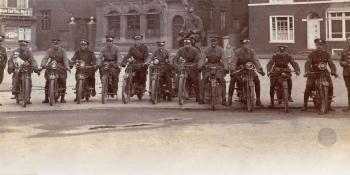words and pictures Richard Pullen
profiles collectable items linked to one remarkable feat of engineering: the jerrycan
If an army can’t move, it can’t fight. Any modern military force needs to be mobile and vehicles such as tanks, aircraft, lorries, cars and motorcycles are vital to winning any campaign. In any conflict, mechanised warfare relies entirely on the supply of fuel. Petrol, oil and diesel are key strategic concerns, with the supply of fuel becoming as important as ammunition or food if not more so. If an army can’t maintain the flow of fuel, it will crawl to a stop and the battle will be lost, as has been demonstrated most recently during the Russian invasion of Ukraine. Moving fuel a short distance from a depot to a dump in tankers or by rail is simple enough, but getting it from the railhead to the frontline presents a real problem. In World War One, fuel bowsers, barrels and small cans were used in massive numbers and both sides stockpiled fuel cans all along the Western Front. The British two-gallon cans weren’t a special military design, they were exactly the same as those used by motorists before the war, and although they were vital on the battlefield, they did have a few …


